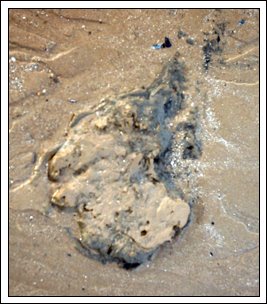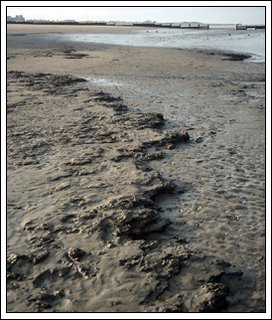The petrified forest, or what remains of it, that can be found on the beach just off Jubilee Gardens in Cleveleys must be one of the best documented examples of the Wyre’s natural history around. We’ve even recorded it ourselves for one of the Wyre Archaeology newsletters, but not before Thornber, Porter, the Cleveleys’ Tourist Board, the Evening Gazette and numerous other sources beat us to it.
Just for the record, however, the photograph below was taken relatively recently and shows how infested the stumps have now become with tiny sea creatures.

Just for the record, however, the photograph below was taken relatively recently and shows how infested the stumps have now become with tiny sea creatures.

The sunken forest off the pier at Fleetwood, however, is a completely different kettle of fish. Hardly surprising, really, seeing as, to the best of our knowledge, it only came to light this year when a new channel from the river mouth began to cut its way through the silt. In fact the first we knew about these ancient stumps (always working on the assumption that’s what they are, of course) was when one of us (not mentioning names) sank up to her boots in what appeared to be peat whilst paying too much attention to the mountains across the bay. The photograph below shows a typical example of a gelatinous tree stump...without a boot print.

It’s long been known that these ancient submerged forests stretch right around the west coast of England, but none have been found, to the best of our knowledge, off Fleetwood…until now. Just in case you think we might have uncovered an old breakwater by accident or something, the photograph below shows the area that the soggy stumps cover, stretching all the way from the end of the pier to Rossall Point.

Admittedly the trees aren't exactly in the best of condition nowadays, only just recognisable by their woody contours and root-like crevices, extremely soggy and liable to break up in your hands.
But they are there…or at least they appear to be. And they’re beech trees as the blackened leaves we discovered in situ demonstrated.
Another small find we unearthed amongst them (albeit an obviously much older one) was a fossilized Crinoid (a type of prehistoric cucumber) similar to those unearthed at Stakepool by Headlie Lawrenson in the 1970s which are shown in the scan below.

Obviously the tide had deposited our own crinoid onto the stump, unless the beech trees themselves somehow managed to grow under water, but such items always make fascinating finds.
The leaves weren’t the only surviving bits and pieces. We also discovered two small sections of bark along with a moss stock that exhibited signs of having been felled by means of a small axe. Both of these might have been connected to the submerged forest, although they might just have easily been carried in on the tide…so we don’t want to make too many commitments at the moment.
Nonetheless, the beech forest does seem to be there and appears to be ancient. Despite the stumps being somewhat unstable we took a couple of samples for testing although, to date, we're still waiting on the results. In the meantime, please send us your speculations about windbreaks for Portus Setantiorum, housing materials for the missing village of All Hallows (‘Where the Wyre Goeth into the Sea’) or an area of Mesolithic hunting land now reclaimed by the bay, on a postcard to the usual address.

It’s long been known that these ancient submerged forests stretch right around the west coast of England, but none have been found, to the best of our knowledge, off Fleetwood…until now. Just in case you think we might have uncovered an old breakwater by accident or something, the photograph below shows the area that the soggy stumps cover, stretching all the way from the end of the pier to Rossall Point.

Admittedly the trees aren't exactly in the best of condition nowadays, only just recognisable by their woody contours and root-like crevices, extremely soggy and liable to break up in your hands.
But they are there…or at least they appear to be. And they’re beech trees as the blackened leaves we discovered in situ demonstrated.
Another small find we unearthed amongst them (albeit an obviously much older one) was a fossilized Crinoid (a type of prehistoric cucumber) similar to those unearthed at Stakepool by Headlie Lawrenson in the 1970s which are shown in the scan below.

Obviously the tide had deposited our own crinoid onto the stump, unless the beech trees themselves somehow managed to grow under water, but such items always make fascinating finds.
The leaves weren’t the only surviving bits and pieces. We also discovered two small sections of bark along with a moss stock that exhibited signs of having been felled by means of a small axe. Both of these might have been connected to the submerged forest, although they might just have easily been carried in on the tide…so we don’t want to make too many commitments at the moment.
Nonetheless, the beech forest does seem to be there and appears to be ancient. Despite the stumps being somewhat unstable we took a couple of samples for testing although, to date, we're still waiting on the results. In the meantime, please send us your speculations about windbreaks for Portus Setantiorum, housing materials for the missing village of All Hallows (‘Where the Wyre Goeth into the Sea’) or an area of Mesolithic hunting land now reclaimed by the bay, on a postcard to the usual address.



















No comments:
Post a Comment